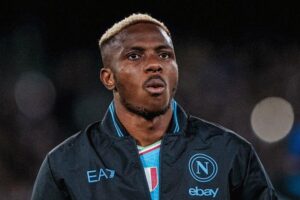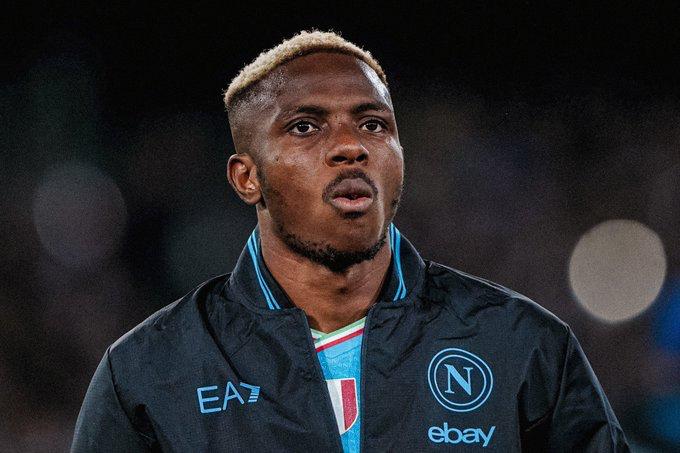
When the revamped UEFA Champions League kicks off in ten days’ time, Victor Osimhen, the African Footballer of the Year, might be watching on television. Having beaten Achraf Hakimi and Mohamed Salah to the prestigious individual award in 2023, Nigeria’s Osimhen will spend at least the first half of the season playing in the second-tier Europa League for Istanbul’s Galatasaray. For one of the most lethal strikers of his generation, the theme music of Champions League nights – which even Cristiano Ronaldo said used to fuel his dreams – will have to wait.
How did it get to this? How was it possible that a transfer window came and went without Osimhen joining a club playing in the Champions League? Why was the divorce with Napoli, where he was once a cult hero, so ugly? There are no easy answers.
Few cities on the planet take their football as seriously as Napoli. The eternal underdogs from southern Italy have traditionally trailed in the wake of the more affluent clubs from the north. The history of Italy football is essentially the story of Juventus and the two Milan clubs, AC and Inter. One of the periods of disruption was in the 1980s, when the late Diego Maradona inspired Napoli to their first two Serie A titles after transferring from Barcelona in the summer of 1984.
Such was the joy when the first Scudetto was clinched in 1987 that Partenopei fans spray-painted graffiti outside one of the city cemeteries. “You don’t know what you missed,” it said. But after those glory years – another championship was won in 1990 – both Maradona and the football team faded away. They were relegated in 1998, and fell as far as Serie C1 in 2004.
But though Napoli revived to such an extent that there were seven top-three finishes between 2010 and 2019, the third title remained a distant dream. Coaches like Walter Mazzarri, Maurizio Sarri and Carlo Ancelotti – each more celebrated than his predecessor – got the club as far as second without being able to take the final step.
But if it was Maradona that was the catalyst for 1980s glory, the spur for modern-day success came from a Georgian the fans quickly nicknamed Kvaradona. Khvicha Kvaratskhelia cost just 10 million Euros from Dinamo Bitumi, but his speed, strength and trickery on the left wing transformed a team that had been reeling from the losses of Lorenzo Insigne, Dries Mertens and Fabian Ruiz in the summer of 2022.
Kvaratskhelia’s understanding with Osimhen that season was almost telepathic. When they were both on song, the team was almost unplayable. Jurgen Klopp’s Liverpool, who had come within 180 minutes of a quadruple in 2021-22, were torn to shreds 4-1 in a Champions League group game in the autumn of 2022. And but for an injury to Osimhen late in the season, they probably wouldn’t have lost to Milan in the last eight.
As it was, Napoli romped to the Serie A title with 90 points,16 ahead of Lazio in second. Despite missing six games, Osimhen was miles clear at the top of the goal-scorers’ chart, with 26 goals to Lautaro Martinez’s 21.
But then, Luciano Spalletti, who had done what even Ancelotti couldn’t, left to take charge of Italy, and the hapless Rudi Garcia took over. Mazzarri had replaced him by November, but could work no miracles as Napoli limped to a dismal 10th-place finish with 53 points. Osimhen’s injury-interrupted season saw him score 17 times in 32 games, including 15 from 25 Serie A outings. It was hardly a poor return, but by season’s end, the bond between player and club was completely fractured.
Osimhen and his agent had been angling for a big move, but Napoli did themselves no favours with an outrageously stupid social media post mocking an Osimhen penalty miss. By the summer, with his release clause set at a prohibitive 130 million Euros, it was clear that very few clubs could afford him. Napoli agreed terms with Al-Ahli in Saudi Arabia, but Osimhen had no interest in moving to a league of has-beens.
With Romelu Lukaku sold to Napoli for less than one-third of what they had paid for him, Chelsea couldn’t afford the combination of transfer fee and salary either. Others were simply unprepared to break their wage structure to accommodate a player who has something of a reputation as a maverick.
English clubs, in particular, are especially wary. Ghana’s Asamoah Gyan arrived at Sunderland after a stellar World Cup in 2010, and lasted a season before he scuttled off to the UAE. Nearly a decade earlier, the much-hyped El Hadji Diouf turned out to be one of the most unsuccessful, and unpopular, signings in Liverpool history.
Osimhen has probably done himself a favour by sacking his agent and negotiating his move to Turkey. But it’ll be a long way back from across the Bosphorus to the top table of European football.
For more sports content: https://revsportz.in/





